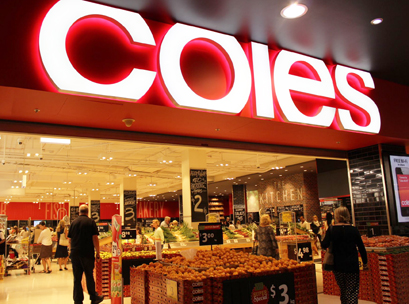 A moderation in food deflation and basket size increases have helped drive sales for Coles, while Target and Bunnings UK & Ireland (BUKI) have struggled, resulting in a 2.8 per cent increase in Wesfarmers’ third quarter retail sales to $14.4 billion.
A moderation in food deflation and basket size increases have helped drive sales for Coles, while Target and Bunnings UK & Ireland (BUKI) have struggled, resulting in a 2.8 per cent increase in Wesfarmers’ third quarter retail sales to $14.4 billion.
Coles’ managing director John Durkan affirmed his view that the soon to be spun off chain would return to earnings growth in the second-half on Thursday, telling analysts that both comparable sales and sales per square metre were on an improving trend.
“Our sales are slightly ahead of where I said they would be at the half and therefore there’s no change to our earnings outlook that we gave then,” he told analysts.
Coles has been working to claw back sales momentum over the course of the last financial year in the midst of a resurgence from rival chain Woolworths.
Coles’ top line revenue grew by 0.3 per cent to $9.04 billion for the three months ended 31 March, constrained by an 8 per cent decline in convenience sales, which partly offset a 1.9 per cent increase in food and liquor to $7.7 billion.
Food comps were up 0.9 per cent for the quarter, a three-fold increase in Coles’ first quarter performance but weaker than the 1.4 per cent increase booked in the second quarter.
Although food and liquor comps adjusted for the timing of New Year’s Day and Easter were up 1.3 per cent, 0.3 per cent ahead of the second quarter. Financial year to date (FYTD) food and liquor comps were up 0.9 per cent.
Sales were aided by a moderation in price deflation which declined by 0.7 per cent during the third quarter, down from 0.9 per cent in the second quarter. This has brought FYTD price deflation to 1.3 per cent.
Coles managing director John Durkan said on Thursday that Coles had continued to invest in price with a slight slowdown in transaction growth from the second quarter being offset by an increase in basket size.
“We’re in the place we wanted to be, of course we’d like to see more but we’re going in the right direction,” Durkan said.
Coles postponing investment?
However, analysts have suggested that Wesfarmers may be looking to safeguard Coles’ earnings at the expense of sales ahead of its planned demerger of the business.
Citi analysts said that underlying like-for-like sales growth of 1.3 per cent demonstrated a lack of sales momentum, despite a boost from improved deflation and investment in Coles’ Sports for School program.
“In-store execution remains the major headwind to Coles’ improvement, and is unlikely to runaround quickly without significant investment,” Citi analyst Bryan Raymond said.
“The timing of this investment is unlikely to occur prior to a Coles demerger as, in our view, management is prioritising near term earnings stability over turning around sales momentum.”
Durkan dismissed suggestions that Coles was trying to protect earnings at the expense of sales, telling analysts that the business “is, and always has been” primarily focused on its sales line.
“[We’ve] added more resource into our stores to grow our sales in the last quarter rather than less, we’ve invested more in customer service,” Durkan explained.
Tell Coles customer satisfaction metrics were the best they have been in seven consecutive quarters, after the business increased its staffing investment to bolster service.
Coles dropped the price on 500 products in the third quarter, but Durkan said that promotional participation had continued to decline as every day low price sales increased.
Coles’ recently approved enterprise agreement was signalled as a small headwind for the second-half, but rising sales are expected to offset this.
A 14.6 per cent decline in fuel volumes drove a weaker result in convenience, more than offsetting a 0.9 per cent increase in top line convenience store sales.
Durkan said Coles continues to work with its partner on declining fuel volumes and the direction of Coles’ long-term outlook for that side of its business.
BUKI continues decline
Bunnings Australia and New Zealand (BANZ) saw sales increase by 8.9 per cent to $3.04 billion, although BUKI sales declined by 6.5 per cent to $374 million.
BUKI, which Wesfarmers is reviewing and may sell off in the coming months, has seen store-on-store sales decline by 15.4 per cent in the third quarter, down 13.9 per cent for the FYTD.
Wesfarmers managing director Rob Scott would not provide any updates on the overseas venture on Thursday, deferring to the conglomerate’s upcoming strategy day in June.
Bunnings Group managing director Michael Schneider said that improved first quarter trading in the UK was offset by severe weather in March, but that “satisfactory” progress had been made on improving the Homebase network.
“Retail execution standards lifted in Homebase in preparation for spring and stores are well positioned for the arrival of the season,” he said. “Refinement of the Bunnings format is ongoing with recent conversions reflecting updated range plans.”
BANZ has continued its momentum, with a 7.7 per cent increase in store-on-store sales. Year-to-date total sales were up 9.6 per cent to $9.6 billion, up 8.6 per cent FYTD
Five Bunnings’ warehouses were opened in Australia during the quarter, with a further 17 still under construction, including six former Masters’ conversions.
There were eight Bunnings pilots opened in the UK during the third quarter and seven Homebase stores closed, four for conversion and three permanently. There were 227 Homebase stores and 23 Bunnings stores in the UK as at 31 March.
Target struggles
A two per cent decline in Target’s sales to $1.29 billion in the third quarter once again held back Wesfarmers’ department store division as Kmart continued its top line momentum, booking a 10.2 per cent increase in sales to $1.24 billion.
Target’s comparable sales declined by 2.6 per cent for the quarter but were worse when adjusted for the earlier Easter timing, down 3.2 per cent on an adjusted basis.
Target’s FYTD sales showed a 5.2 per cent decrease in revenue and a 5.5 per cent decline in comparable sales.
Wesfarmers’ department stores chief executive Guy Russo said the Target figures reflect ongoing efforts to turnaround the business, including resetting price, range and product.
“During the quarter the business continued to focus on improving fashionability and the quality of sales,” Russo said.
Toys and general merchandise were singled out as declining categories for Target, offsetting online sales and increases in apparel and homewares.
Kmart was much more positive, experiencing comparable store sales by 6.8 per cent for the third quarter.
FYTD sales have increased by 9 per cent, while comparable store sales were up 6 per cent.
Kmart managing director Ian Bailey said Kmart had delivered a solid quarter, supported by home, kids and general merchandise.
“Sales performance throughout the third quarter was driven by an increase in customer transactions with al categories, except family entertainment, achieving double digit unit growth,” he said.
Kmart opened three new stores in the quarter, including one Target rebrand, and completed four store refurbishments.
Officeworks impacted by Easter
Officeworks sales were up 7.2 per cent to $598 million for the quarter, impacted by the earlier timing of Easter. FYTD revenue was up 8.8 per cent to $1.6 billion.
“The ongoing work within Officeworks to strengthen and expand the customer offer continued to produce strong results,” Officeworks managing director Mark Ward. “The critical back-to-school trading period also delivered a strong start to the second half of the financial year.”
Officeworks opened two stores and closed one in the third quarter.
UPDATED 14:35 AEST
More to come.





